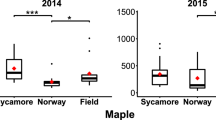Abstract
Urban tree deterioration is a common problem all over the world. Inappropriate plant species choice and inadequate planting may lead to micro and macro organism attacks, such as pests and diseases. Subterranean termite damage is common and may promote tree falls. In order to help urban forestry planning, this work was carried out for 9 years on 1477 street trees in a neighborhood in the city of São Paulo, Brazil. Plants were identified to species, grouped as native, exotic plants, and palm trees, and their measures of circumference at breast height (CBH) were taken, in order to evaluate if subterranean termite damages are related to tree size and plant group. Four subterranean termite species were identified infesting up to 27% of the plants, with Coptotermes gestroi (Wasmann) being the most common. Palm trees were not damaged by subterranean termites, while native plants are the most susceptible, especially Caesalpinia pluviosa var. peltophoroides (Fabaceae). Among the native plants monitored C. pluviosa var. peltophoroides, Caesalpinia ferrea var. leiostachya, Erythrina speciosa, Piptadenia gonoacantha (Fabaceae), Gochnatia polymorpha (Asteraceae), Tibouchina granulosa (Melastomataceae), and Handroanthus spp. (Bignoniaceae), the latter was the least damaged. Exotic plants were also susceptible with the exception of Lagerstroemia indica (Lythraceae) and Platanus acerifolia (Platanaceae). Correlation analysis showed that the higher the CBH value, the higher the percentage of internal damage by C. gestroi. Infested trees were treated with imidacloprid and thiamethoxam, and subterranean termites were effectively controlled during the 9-year study.


Similar content being viewed by others
References
Amaral RDAM (2002) Diagnóstico da ocorrência de cupins xilófagos em árvores urbanas no bairro de Higienópolis, na cidade de São Paulo. Dissertation, ESALQ, Universidade de São Paulo, Brasil, p 71
Castillo L, Rossini C (2010) Bignoniaceae metabolites as semiochemicals. Molecules 15:7090–7105
Constantino R (2000) Key to the soldiers of South American Heterotermes with a new species from Brazil (Isoptera: Rhinotermitidae). Insect Syst Evol 31:463–472
Constantino R (2002) An illustrated key to Neotropical termite genera (Insecta: Isoptera) based primarily on soldiers. Zootaxa 67:1–40
Costa-Leonardo AM (2002) Cupins-Praga. Morfologia, Biologia e Controle. Universidade Estadual Paulista, Rio Claro, p 128
Cowie RH, Logana JWM, Wood TG (1989) Termite (Isoptera) damage and control in tropical forestry with special reference to Africa and Indo-Malaysia: a review. Bull Entomol Res 79:173–184
Daniel O (2006) Silvicultura. Universidade Federal da Grande Dourados, Dourados, p 196
Emerson AE (1952) The Neotropical genera Proconitermes and Cornitermes (Isoptera, Termitidae). Bull Am Mus Nat Hist 99:475–540
EPA (2014) Groups of pesticides in registration review: neonicotinoids. http://www2.epa.gov/pesticide-reevaluation/groups-pesticides-registration-review#neonic. Accessed 19 Nov 2014
Grey GW, Deneke FJ (1978) Urban forestry. John Wiley, New York, p 279
Haagsma KA, Rust MK (2007) The effect of imidacloprid on mortality activity, and horizontal transfer in the Western subterranean termite (Isoptera: Rhinotermitidae). Sociobiology 50:1127–1148
Krishna K, Araújo RI (1968) A revision of the Neotropical termite genus Neocapritermes (Isoptera: Termitidae, Termitinae). Bull Am Mus Nat Hist 183:135–222
Lorenzi H (2002) Árvores brasileiras: manual de identificação e cultivo de plantas arbóreas do Brasil, vol. 1. Instituto Plantarum, Nova Odessa, 4a. edição p 368
Mori NT, Moraes MLT, Morita CM, Mori ES (2012) Genetic diversity between and within populations of Handroanthus heptaphyllus (Vell.) Mattos using microsatellite markers. Cerne 18:9–15
Osbrink WLA, Lax AR (2003) Effect of imidacloprid tree treatment on the occurrence of Formosan subterranean termite, Coptotermes formosanus Shiraki (Isoptera: Rhinotermitidae), in independent monitors. J Econ Entomol 96:117–125
Parma V, Vargo EL (2010) Colony-level effects of imidacloprid in subterranean termites (Isoptera: Rhinotermitidae). J Econ Entomol 103:791–798
Remmen LN, Su NY (2005) Tunneling and mortality of Eastern and Formosan subterranean termite (Isoptera: Rhinotermitidae) in sand treated with thiamethoxam or fipronil. J Econ Entomol 98(3):906–910
Siegel S (1979) Estatística não-paramétrica. MacGraw Hill do Brasil, São Paulo, p 350
Wolf KL, Krugger LE (2010) Urban forestry research needs: a participatory assessment process. J Forest 108:39–44
Zar JH (1999) Biostatistical analysis. Prentice Hall, Upper Saddle River, p 663
Zorzenon FJ (2009) Levantamento, dimensionamento de danos e manejo de cupins subterrâneos e formigas carpinteiras em arborização urbana. Dissertation, Instituto Biológico, São Paulo, Brasil, p 133
Zorzenon FJ, Campos AEC (2014) Methodology for internal damage percentage assessment by subterranean termites in urban trees. Sociobiology 61:78–81
Acknowledgments
The authors thank Dr Clive Boase from the Pest Management Consultancy, UK, for reviewing and improving the English on an early draft. Thanks also go to anonymous referees whose suggestions improved the manuscript.
Author information
Authors and Affiliations
Corresponding author
Additional information
Edited by Jorge B Torres – UFRPE
Rights and permissions
About this article
Cite this article
Zorzenon, F.J., Campos, A.E.C. Subterranean Termites in Urban Forestry: Tree Preference and Management. Neotrop Entomol 44, 180–185 (2015). https://doi.org/10.1007/s13744-014-0269-y
Received:
Accepted:
Published:
Issue Date:
DOI: https://doi.org/10.1007/s13744-014-0269-y




